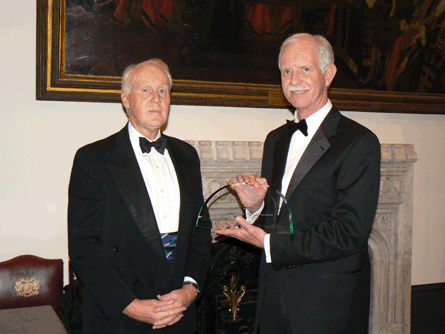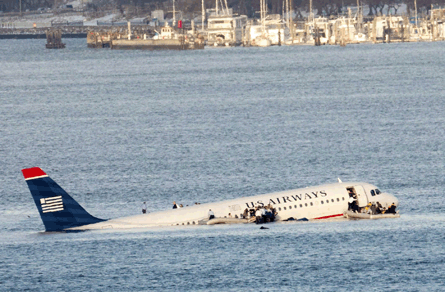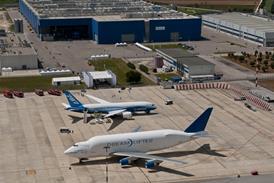When news broke in January 2009 of a US Airways Airbus crashing into the Hudson River off New York, most people imagined another terrible tragedy had befallen the city. Aircraft simply did not plunge from the sky into water without significant - usually total - loss of life.
Shortly, however, it emerged that, rather than breaking up and sinking, the pilots had - despite losing complete engine power after hitting birds minutes after take-off from La Guardia airport - engineered a near-perfect landing and the crew had managed to evacuate all the passengers.
In a stroke of luck, commuter ferries gearing up for the morning rush hour were on hand to pluck everyone from rafts and the wings of the aircraft as the cabin slowly filled with freezing water. Aside from cuts and bruises, and some mild cases of hypothermia, there were no serious injuries.
 |
|---|
© Andrew Costeron/FlightglobalCapt Sullenberger receives his award for aviator of the year from Flight International's Operations & Safety Editor David Learmount |
In another piece of fortune, in command of Flight 1549 that day was one of US Airways' most experienced pilots. In his late fifties, Captain Chesley Sullenberger was a former Phantom pilot who had been named outstanding cadet in airmanship in his graduating class at the US Air Force Academy.
The native Texan was also a safety expert for the Air Line Pilots Association and had served on a number of accident enquiries. He had his own safety consultancy business in his home town in California.
However, for all his track record in the safety arena, it was quite a different matter when moments into a routine flight, he and co-pilot Jeff Skiles had to deal with a real crisis themselves.
As Sullenberger recalls in his just-published autobiography, Highest Duty, seconds before the bird strike it had been another day in the office. As the airplane taxied for take-off he admired the stunning Manhattan skyline and looked forward to making it home from his destination in Charlotte to San Francisco in time to see his wife and young daughters before they went to sleep.
"We'd been in the air for about ninety-five seconds, and had not yet risen to three thousand feet when I saw them," he recounts of the moment that turned an everyday journey into a potential disaster. "'Birds!' I said to Jeff."
The cockpit recorder captures not only the exchange between the two pilots but the thumps and thuds of birds hitting the aircraft - "like the worst thunderstorm I'd ever heard back in Texas" - and the sickening sound of engines protesting and shutting down.
"I heard the noise of the engines chewing themselves up inside, as the rapidly spinning, finely balanced machinery was being ruined, with broken blades coming loose," Sullenberger goes on.
 |
|---|
© Sipa Press/Rex Features |
From then on, Sullenberger and Skiles had to draw on every last drop of experience and ingenuity, while staying calm and taking split-second decisions. With a call of "My aircraft", the captain took control, with his co-pilot handling the emergency checklist.
"Within eight seconds of the bird strike, realising we were without engines, I knew that this was the worst aviation challenge, I'd ever faced," he says. And, although later praised for his incredible calmness and coolness in the face of what seemed like the very high likelihood of a terrible accident, Sullenberger admits to being petrified: "It was the most sickening, pit-of-your-stomach, falling-through-the-floor feeling I had ever experienced."
The actions of Sullenberger and his crew were described as a miracle, courageous and heroic. While they were all these things, a modest Sullenberger puts them down to years of learning that equipped him to take the right decisions when it mattered.
"Jeff and I had met just three days before we flew Flight 1549," he says in his book. "Yet during this dire emergency - with no time to verbalise every action and discuss our situation - we communicated extraordinarily well. Thanks to our training, and our immediate observations in the moment of crisis, each of us understood the situation, knew what needed to be done, and had already begun doing our parts in an urgent yet cooperative fashion."
FINALISTS
- Jose Miguel Ceppi
Latin America's record in aviation safety has been patchy, but Jose Miguel Ceppi has done much to improve things. As head of the Latin American Regional Cooperation System for Safety Oversight until July, Ceppi spearheaded a process to harmonise regulations and inspection manuals among the region's states. The work has also spawned seminars, courses and conferences, which, according to a colleague who has worked with the former International Civil Aviation Organisation South American regional office director, will "contribute significantly to safety in the region". Ceppi, he maintains, approached the task with "great dedication and knowledge".
- Iren Dornier
He may have inherited one of the most famous surnames in the industry, but Iren Dornier is a highly-successful aviator and enterpreneur in his own right. A grandson of German aircraft pioneer Dr Claude Dornier, he is a flight instructor and pilot imbued with a love of aviation. His projects include a new range of seaplanes, including the soon-to-be certificated single-engine S-Ray 007, based on a 1921 Dornier design. He runs Philippines amphibious airline Seair, owns watches and fashion brands, and has since 2004 visited 90 countries in a restored 1944 Dornier-24 to raise awareness of UNICEF education projects.
- Ruedi Hafen
The man who plunged over the Niagara Falls on the US-Canada border in March did not want to be saved, but local helicopter pilot Ruedi Hafen refused to give up. Following up an emergency call in March, Hafen - founder of tourist flight operator Niagara Helicopters - hovered his Bell 407 over the drowning man, so a police officer could attach a sling to his arm. When the would-be suicide resisted, Hafen used the aircraft's downdraft to push the man safely to shore. Swiss-born Hafen -who has taken Niagara Helicopters to $6 million revenues in 20 years - was praised in media coverage for his courage, quick-thinking and airmanship.
Source: Flight Daily News




















